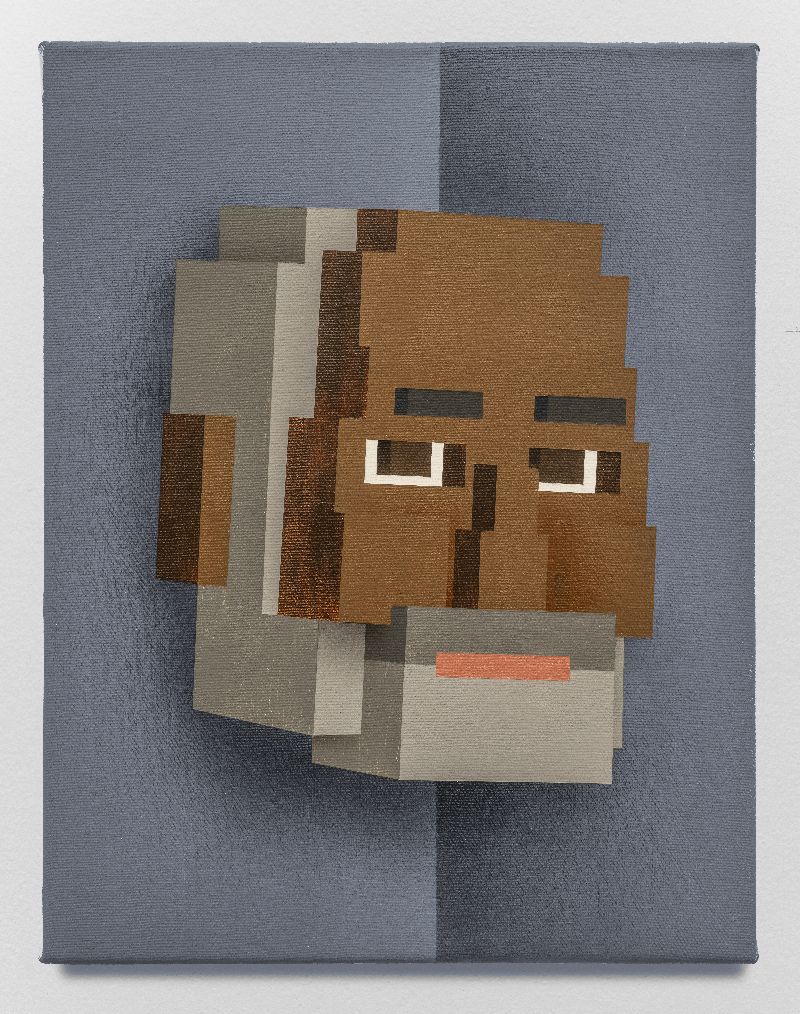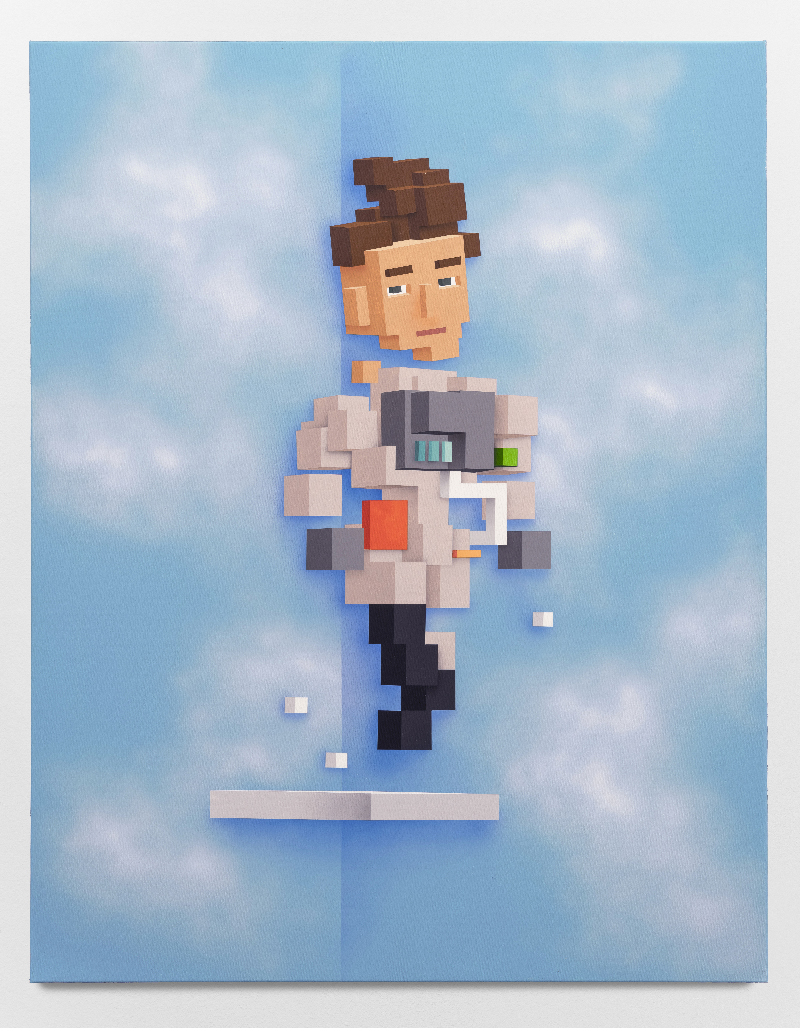Artist Interviews 2022
Sepand Danesh 
By Johnny Otto

Your recent work looks like computer generated Voxels. Why use this style to convey your messages? How did you get started painting these and can you explain your technique and methods?
The characters I paint in my corners are all made by the same fragment, a cube-shaped geometrical volume called "voxel". All the cubes in all my paintings have the same proportion no matter if it is a big or a small painting. In this way, in addition to the permanent presence of the corner in my work, the viewer feels there is a consubstantiation between all the characters too. The first artwork I did was to draw small square shaped drawings on A4 papers. Since then, I did hundreds of thousands of drawings trying to fragment my immediate environment as a child who was born during war, survived psychological and physical violence during primary school in Tehran and lived a traumatic experience of loss of language and social status due to immigration. My characters are assemblages made by combinations of cubes. I believe those characters appear because it’s maybe the right moment for me to rebuild and reconstruct a life of my own. The digital aspect comes from the fact that my thoughts are produced in between my interior world made of memories and imagination and an exterior world of physical needs and social interactions. I needed a virtual aesthetic to fulfill the space in between those two worlds. I have been thinking and philosophizing my entire life to create a conceptual artwork with a multilayered approach, capable of representing and reoccurring paths and schemes of psychological and cognitive behaviors.

Who are some of your earliest influences or what experiences made you want to become an artist?
I grew up for the first twelve years of my life in a very violent environment due to the political situation of the country in which I was born, family traumas and crises related to the execution of my grandfather in the aftermath of the revolution. When I was in Iran, I always felt stock-in and wanted to somehow escape. After we left Iran, I experienced a new kind of inability because I was marginalized and pushed out, in consequence of what, I felt excluded or stock-out. That is the main reason why I started drawing, because I couldn’t find my place and the world around me felt like a big mess I couldn’t interact with. Nevertheless, I had the chance to meet amazing people in my life that led me to a way of thinking about life as a potential production of space, no matter if it is physical, mental, philosophical or a mixture of all.

Are we still ourselves if we are just our heads?
In the branch of philosophy called Philosophy of mind, the Theory of Double Aspect defines the mental and the physical as two aspects of the same substance, indivisible and complementary. Neutral Monism rejects the dichotomy of those two aspects and defines a territory of neutrality of mind and matters which places reality as neither one nor the other. It is Idealism that makes the mind (though perception) be the fundamental feature of human reality as opposed to Physicalism which defines reality as one matter, one substance. Let’s slightly deviate because I believe your question is related to the floating head in corners that are in the Los Angeles show. Piet Mondrian, Kerry James Marshall, Paul Cezanne and Giuseppe Penone among many others are the people that have influenced me because of their ideas and their works. The absence of their bodies in the portraits I made of them is to face the viewer with the inevitable fatality of death. When I lost my father five years ago, a friend of mine from Mexico sent me this: We die three times, once when our mind is gone, once when our body is gone and then when our memory is gone. I wanted to paint those portraits to create and maintain a memory of them. I have read, seen and admired their works and somehow, I have tried to create a connection with them.

Has technology made us less human?
Technology is a tool like anything else, it allows humans to assess their values, to evaluate, estimate and sometimes expand their natural abilities, or qualities. The only risk is to become passive users and by that, to reduce the variability of our unconscious paths. I have created a grid (Encyclopedia Of The Imagination) in which I ask people to draw whatever crosses their minds. The grid purpose is to fragment one’s mind into multiple inflexions of thoughts producing a path specific to each person. I was amazed to see that some people have the exact same path even if they are not the same age, neither the same sex, nor the same culture. A question arose from this experimentation: is there a level of collective consciousness that is still to be discovered that could define us as something other than the absoluteness of our mental or physical behavior? Can technology allow us to fragment our mind ad infinitum?

Tell us about your current exhibition and how that came about and what you learned or experienced.
When I left Iran, I moved to Los Angeles with my Mom and my 4 years old sister. My parents lost a major part of their assets by investing in a trustworthy friend that happened to be a fraud. The utopia of a better life in a new world of opportunities became a dystopia of additional traumas to what I had already experienced in Iran. The months we spent in California and especially the time in Los Angeles was for me an empiric and fundamental life experience as transportation, money and even language were to be core obstacles to our integration. My Mom used to work in the French Embassy in Iran and spoke French, this is how we ended up living in a Parisian suburb, starting from scratch. We left Los Angeles, but I didn't want to admit defeat and for many years my time in Los Angeles stuck with me as an unfinished chapter of my life I had to reclaim. Later, I studied its urban structure, compared it to the writings of Gaston Bachelard about time. I believe that I have maybe based the hidden structure of my art works (the grid in my drawings, the corners and the fragmented characters of my paintings on the deep feeling of disorientation I experienced in Los Angeles, considered as the model of post-modern urban structure from which I tried to escape. The name of the show, Fear of Collapse is related to those early life experiences but also to their following sequels constitutive of my adulthood.

Who would you love to collaborate with?
I believe the list of people would be endless. I have created my artwork as a platform for experimentation and would like for anybody to get to appropriate the logic of it and produce their own models. I find beauty in the combination of three basic components of creation: order, disorder and rupture. I would like to collaborate with researchers from any disciplines interested in those structural categories.

How does music influence your art? Who do you listen to and how does it affect your work?
I love instrumental music. Lately I have been listening to Nils Frahm. Music is the emotional generator that I can’t figure out. I have had musical bonds with people more powerful than any other physical or mental interactions. In my early childhood I had two different ways of experimenting music while discovering it. My mom was friend with some of the most prominent musicians of contemporary classical Persian music and it happened that I was present during their rehearsal and witnessed those very moments when music is flowing in unexpected waves as it was improvised. Parallel to that, my dad listened to occidental classical music and had a collection of Audio CDs. The cover of the CD’s was painted portraits of the composers and I used to personify them as a mind game while listening to their compositions. For a long time, I thought people in the West looked like those people in white wigs.

What is next for you?
If I look back at my earliest paintings, the corners have always been there but the aesthetic has completely changed. It didn’t happen fully consciously but because I, myself, have changed. All the readings and new experiences, the travelings and the
exhibitions I am making now will certainly bring new information I will need to process. I have upcoming projects in Singapore and Seoul early 2023. I will discover new cultures, places and people which make me feel very enthusiastic. For those projects I want to be able to go even further in my quest for exploring and inquiring within the experience of the human condition.

|
|

